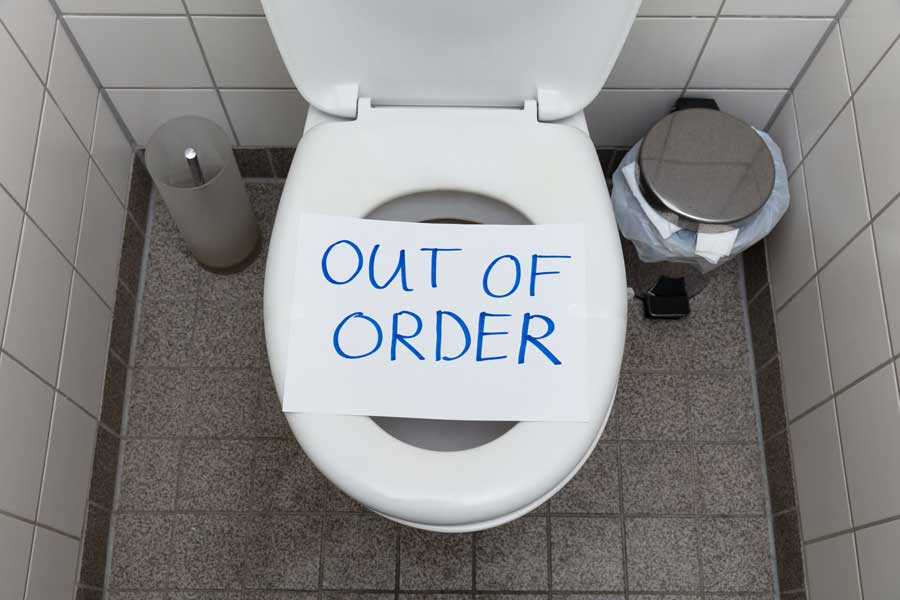There is one universal situation that makes anybody’s heart race, causes panic to settle in, and turns their face red with embarrassment– a clogged toilet. Whether you’re at your friend’s house, in the middle of your work day, or home alone, clogging a toilet is one of those taboo topics no one dares to discuss. However, we are here to tell you that it might not have been you! There are multiple reasons a toilet refuses to flush, and we are here to get you in-the-know and show you tips on how to resolve this cringy crisis.
Why Isn’t The Toilet Flushing?
A Blockage in the Drain Line
Sewage cannot pass through a drain when the line is obstructed. Blockages not only result from regular waste, but also form when hair, sanitary products, dental floss, medicine, diapers, or too much toilet-paper, is flushed down the toilet. So, chances are you are not the sole culprit of a clogged toilet when you encounter one.
How to Get Out of this Jam: If water begins to rise, don’t keep flushing–do turn off the water. The water valve lives behind a toilet, and can be shut off by turning the valve to the right. Congrats, you have avoided a flood! Now, time to grab the plunger. Before you begin, make sure you establish a good, forceful connection between the plunger and the toilet. Then, moving the plunger up and down, perform repetitive, fast motions to create suction. Complete this task until the clog and water begin draining. Once the toilet is no longer in critical condition, you can turn the water valve to the left to resupply water to the toilet. If this does not work, call us–it’s time for licensed plumbers to step in and restore the drain.
Low Water Levels in the Tank
Most people don’t inspect a toilet before conducting their business, but we will give you an inside tip–look at the water level inside of a toilet bowl before using it, as low levels pose potential dangers for a blockage to occur. Low water levels are typically an issue of partial obstructions, but may also indicate a problem with the toilet’s flapper. A flapper is the round, rubber stopper inside of your toilet’s tank. If it is defective, the flapper will not open when you flush the toilet, leaving you with a weak flush, and in jeopardy of causing a clog.
How to Rise Up to This Occasion: To rectify this situation, remove the tank cover on the top of the toilet. Once you’re in, you will see a round, rubber stopper, or the flapper, which is attached to a chain. This chain is responsible for pulling this gasket open when you flush the toilet. In order to restore a normal water level in the toilet, simply shorten the chain! Then, try flushing the toilet. If it is still not flushing properly, continue to reduce the length of the chain, and test it again. Rinse and repeat until your toilet is back at a normal water level.
The Trap is Finicky
The trap is a u-shaped pipe responsible for keeping foul smells from creeping back into your home. Water is supposed to remain in this u-shaped pipe at all times, acting as a wall between you and the sewage. So, if there is a foul, sewage smell when you enter a bathroom, it is probably smart to conduct your business in a different location to avoid further complications. Additionally, this pipe is not called a trap for nothing–the bent-shape of the pipe provides the perfect place for a clog to form, even when it is functioning properly. No signs here, just bad luck.
How to Untrap Yourself: In order to release a blockage in the trap, you will need to call a professional, as a normal plunger will not alleviate this type of blockage.
Aged-Out Pipes
You may be thinking, how am I supposed to know if my pipes are old? Well, if you are experiencing issues with multiple drains at once, this is a good sign that your pipes are no longer in their prime. Backflow is also a good indicator that your pipes may be “antique”, and will cause sequential clogging.
How to Deal with Senior Pipes: You guessed it, time for a professional to step in! When you are experiencing clogs in multiple drains, your pipes need replacing.

